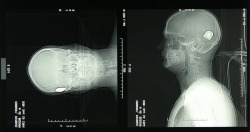Cochlear Unites
Facts

- Over 31.5 million Americans are affected by some degree of hearing loss [4].
• In 2003, the average child who was born with profound hearing loss has very low achievements in nearly all communication skills, particularly speech intelligibility, but also in spoke English and English Comprehension. These same children typically graduate from high school reading at the fourth-grade level according to standardized assessments that include the ability to make elementary inferences, the ability to locate and retrieve specific parts of information from text, and the ability to make basic observations over an entire text.[6]
• "The entire process happens in milliseconds so that a 22 channel implant user can virtually hear sounds as they occur. Signals are sent continuously if there is sound present in the environment. Special circuitry exists in the speech processor to reduce unwanted background noise"[7]
• In the United States, one must posses a reading level equivalent to a 10th or 11th-grade just to meet the minimum standards of full participation in society (Marschark & Harris, 1996)[5] . According to this requirement and the previous fact, an estimated 30% of the deaf children graduate high school illiterate. [2]
• Typically, the younger a child who was born deaf is implanted, the greater the benefit achieved in the areas of speech perception and speech and language development.[7]
• "Only 35% of people with hearing loss are older than age 64. There are close to six million people in the U.S. between the ages of 18 and 44 with hearing loss, and more than one million are school age."[1]
Myths

Hearing loss only affects those that are older in age.
Actually hearing loss can happen to anybody, anywhere without family history. In fact only 35% of people who are diagnosed with hearing loss are over the age of 64. [1]
With a cochlear implant, deafness is cured completely and sound is fully restored to its previous quality.
Although the cochlear implant has given those who have severe to profound hearing loss greater opportunities in the hearing world by increasing literacy of the english language, a person receiving an implant cannot hear sound the same as "normal" hearing people. It actually sounds much more robotic. However, recognizing sound is the gracious gift that this technology gives to its recipient. An example is posted here. ( simulation for those who can hear ) Keep in mind, they now make cochlear implants with HighRes and 22 channel processors while this website gives and example of an 8 channel processor.
A Cochlear implant and its related services are NOT covered by insurance companies, especially Medicare and TRICARE.
Now more than ever a cochlear implant is becoming more affordable and versatile to acquire. Most insurance companies including Medicare and TRICARE give benefits to all services involving cochlear implants. [3]
A cochlear implant is a very expensive surgery and should be denoted as a scam because it doesn't actually restore natural hearing.
First of it should be brought to your attention that cochlear implants are very expensive procedures that depending upon certain factors, can range above 40,000 dollars after rehabilitation and post surgery checkups. On the other hand, both John Hopkins University and the University of California-San Diego rank this procedure among the most cost effective ever to be reported. Their studies estimate that the net savings of this procedure average more than 53,000 dollars per child rather than a whopping price tag exceeding one million dollars expected to cost for a child with profound hearing loss before they develop a language. [3]
